Aviazione Ausilaria per la Regia Marina
 Italy (1923-1943)
Italy (1923-1943)

"L'Aviazione Ausiliaria per la Regia Marina (AARM)" or the "The Auxiliary Aviation for the Royal Navy" was an air division of the Italian Royal Air Force (Regia Aeronautica) intended to support the Regia Marina during the interwar and Second World War. After the birth of the Regia Aeronautica in 1923, Italy adopted the principle that all military air forces should be under the command of a single branch. However, the Regia Marina (RM) still needed air support for its naval operations. For this reason, the Auxiliary Aviation for the Royal Navy was created, as a sub-component of the Air Force, dedicated exclusively to the needs of the fleet, but stull under overall control of the air force staff. The main difference was it had some autonomy or action in close link with the Navy, albeit only at this specific operational level, all the rest being managed by the Air Force, included assets and assignations.
This Auxiliary Aviation was mainly responsible for Maritime reconnaissance, Sighting and targeting for naval artillery, Escort and protection of convoys, Attack against enemy naval units, Anti-submarine warfare. The aircraft assigned to this branch were mainly seaplanes, and torpedo-bombers suitable for maritime operations. Famously, the CANT Z.501 & Z.506 for reconnaissance and rescue, the excellent Savoia-Marchetti SM.79 torpedo bomber or the IMAM Ro.43 for reconnaissance from capital ships and cruisers in WW2. Many models followed until these ones in the interwar, started in 1923.
Relationship with the Regia Marina however remained poor at all times, despite the collaboration between the two arms, with tensions between the Regia Marina and the Regia Aeronautica, the former preferring to have a completely autonomous air force, similar to the British Fleet Air Arm. But for a mix of reasons, Italy never developed a completely independent naval air component until the creation of a Naval Aviation post-war. After the armistice of 8 September 1943, the Aviazione Ausiliaria was dissolved. Some units continued to operate with the co-belligerent aviation, while others sided with the German-controlled National Republican Air Force. After the war, with the birth of the Republican Italian Navy (Marina Militare), a true Naval Aviation was established with helicopters and planes embarked on the new Italian aircraft carriers.

CANT Z501 Gabbiano
An aduous history
The Regia Marina did not possess offensive aircraft and was granted, for its particular means, notably naval reconnaissance under Law no. 98, 6 January 1931 with a new organization, part the Regia Aeronautica. The latter had been established as an independent Armed Force in 1923, one of the first in Europe as many countries still had the aviation subservient to the army (like in France). The air units included many cooperating with Armed Forces, unified, with tasks "for" the Regia Marina limited to reconnaissance as seen above, making for a few dedicated floatplanes for cruisers and capital ships. In WWI, Italy experienced the use of a dedicated ship, Europa, but deployment of naval air assets was merely a question of geography and strategy. The immense majority of Italians seaplanes operated over the adriatic from the Italian eastern coast. They benefited from a mostly mild weather, sunny skies, perfect for reconnaissance and a range of missions. In 1916 to 1918, the coordination between the Italian Navy and Aviation was good and enabled many combined operations. It was not perfect, experially given the communication means at the time, but it all died out postwar. Since army, navy and air operations were all closely tied up in the confined of the upper Adriatic, it was the army that was in overall command of the air force.Under the Fascist regime from 1922 the new independent air force was seen as a propaganda tool and assets were not to be distributed around. Before the Aviazione Ausiliaria per la Regia Marina, the Regia Aeronautica was tasked to protect maritime traffic, defending the coast or colonial coasts. But with the AARM, the main change was that Pilots were all trained by the Regia Marina, teaming with observers which were Navy officers. The planes were managed and maintained by regular aviation personal, albeit they still depended operationally on the Navy. The Royal Decree-Law of 22 February 1937 n. 220, and law n. 1501 of 22 June 1937 fixed the details of this interaction.
By June 1940 when Italy entered WW2, the RA (Regia Aeronautica) part assigned to the RM was divided into a maritime reconnaissance and embarked components. 237 seaplanes were assigned to the AARM: 202 Cant Z.501 and 30 Cant Z.506, which for the latter were part of maritime bombing squadrons just being reconverted. The bulk of the seaplane fleet was made of the “Gabbiano” (gull), a single engine parasol model which presented a considerable autonomy but was slow and poorly armed, as well as fragile, way too weak to operate in rough seas. The Cant “Airone” however overcame all these limitations, and had to boot a significant load capacity. Despite growing need for ASW, the auxiliary aviation was still denied any offensive role, and dedicated model.
It was only when the presence of a british submarine was reported, with smoke or gunfire, that the attack was pressed on by surface naval units. Bu the lack of common radio standard prevented an efficient coordination. This shortcoming had severe consequences as no llied submarine was claimed by air action from Italy, despite 70% of these patrols being ASW. Compared to 56% of the Axis tonnage sunk at by allied submarines.
The embarked AARM component comprised 105 Ro.43 biplanes, 44 assigned to capital ships (the two Duilio, Cavour, three Littorio). The Ro.43s was capable of catapult launched but could not be recovered after launch, a real issue. Only Guiseppe Miraglia was capable of carrying 17 seaplanes, launched by catapults, and retrieved at sea with special cranes. But this converted coaler was very slow and could not take in any battle squadron. Efforts were made after the dssiter of Cape Matapan to convert two rfecent, fast liners as aircraft carriers, Aquila and Sparviero, but none was completed when the capitulation was signed in September 1943. A modern modern, versatile Caproni-Reggiane Re.2000 was planned for them.
The aircraft intended for offense, as seen above, were not part of the AARM and instead, belongs were to the Air Force, only. The noew obsolete maritime bombardment units were reformed and re-equipped for better operating against ships. In June 1940, the Regia Aeronautica only had a single experimental torpedo aircraft, the tromotor S.M.79, specially designed for the task and capable of carrying two torpedoes. The Reparto Speciale Aerosiluranti was formed at the end of July 1940 and it became the first experimental squadron (278th from 10 February 1941), a model followed by nine others in 1941. At the end of 1942 these nine autonomous torpedo bomber groups showed promises. However the more units were created as the war progressed, the most losses were registred as allied air presence increased in quality and quantity. The ratio between tonnage hit and attackers decreased sharply from 1940 to 1942, halved in 1942 despite having twice as much of these excellent SM.79 operating. The dive bombing option was in addition never explored by the Regia Aeronautica and only partly solved with the adoption of the German Ju 87 Stuka in Italian units.
Missed opportunities
It is remarkable that Macchi did not developed a naval fighter entirely from the excellent seaplanes from the Schneider Cup, the last of which reached the 700 kph without difficulty. To make it a military version from which the legendary Spitfire derives, Macchi has produced only mediocre star-powered engines before turning to Daimler-Benz online engines. The Italian naval aviation reflected the general condition of the Regia aeronautica in 1940. A modest force numerically, counting devices sometimes behind a generation, often under-motorized. This is one of the reasons for the fact that Italian bomber aircraft are typically powered by three engines instead of two. A technical delay that was much more worrying for the hunt.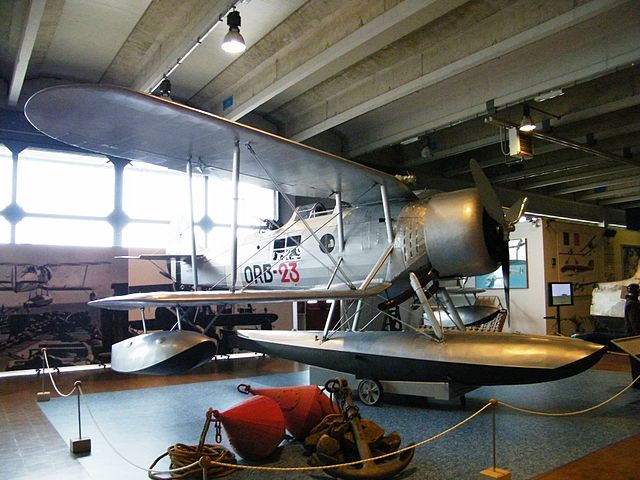
IMAM Ro-43
Other experiments
For a time, when the catapult was operational, the Regia Marina used various aircraft that were land models with floats, the Macchi M18, Piaggio P6 and Cant 25 among others. With the Macchi M41b, derived from a racing machine, it put into service its main embedded fighter, until 1940. But the latter, slow and poorly armed, was totally outclassed at the time of the entry into the war of the Italy. The standard fighter in 1940 was the Ro44, single-seat derivative of the observation Ro43 (1934). Biplane heavy and unwieldy, it lented itself pretty badly to this role but was nevertheless maintained in this role until 1943. In parallel, the Navy tried to adopt the Caproni Reggiane Re-2000 as an onboard fighter, but without floats, which made it a non-reusable gear. Caproni-Reggiane also supplied the navalized Re2001, which tested with a landing gear, intended for use on Aquila and Sparviero. Eventually, the Fiat G55s centauro was a sub-version of the torpedo fighter, of which ten were produced in 1943. CANT Z506R
CANT Z506R

CANT Z506 SAR
The bulk of the number of non-carried seaplanes (but whose aircraft could be used with the Giuseppe Miraglia) consisted of the single-engine Cant z501, and the latter having fallen into disuse, the excellent Airone z506b. On the other hand, shore-based aircraft capable of carrying out anti-ship operations, and large enough to carry one or two standard 457 mm aviation torpedoes, will save Savoia-marchetti Sm79 II bombers and Cant z1007b Alcione bombers. The battle of Matapan and the disaster that showed that lack of radar, aviation could be decisive, caused the decision to convert cruise ships into aircraft carriers. As we know, neither was completed in time. During the two battles of Greater Sirte, and in general, the combined German-Italian against Maltese operations and the British convoys of North Africa demonstrated serious shortcomings in the coordination of Regia Marina with the fleet. The "aircraft carrier Italy" was actually never operational...
 Savoia Marchetti SM.55
Savoia Marchetti SM.55
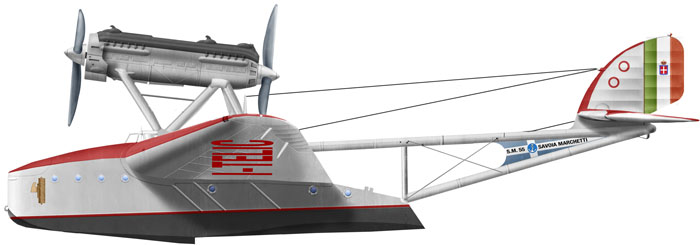
The Savoia-Marchetti SM55X, but not the one of the Pinedo-Italo Balbo Raid, 1932.
The Savoia-Marchetti S.55 (1924) was a pioneering Italian flying boat famous for its distinctive twin-hull design and record-breaking transatlantic flights in the 1920s and 1930s. It was not a military aircraft in the traditional combat sense, but it played a major role in demonstrating the capabilities of Italian aviation during the interwar period. However many were active as patrol torpedo bombers in 1939-42, in service with Italy, Spain, Romania among others. The Italian ones, were still used in reconnaissance, transport, and rescue in WW2.
 Macchi M41
Macchi M41

Fighters used on the cruisers Trento and Bolzano in 1936. These planes participated in the campaign of Ethiopia, and again the first operations of the fleet in 1940, in second line. The last ones were used for schooling.
 CANT z501 Gabbiano
CANT z501 Gabbiano

This multi-purpose hydroplane was the standard unregistered aircraft of the fleet in 1940. It was developed in 1933 and made its maiden flight in 1934. Constructed entirely of wood, 202 units were built. In 1940, it was exceeded, because of a speed of only 275 km / h. They were able to embark 640 kgs. bombs in the hold and counted three defensive turrets, but suffered heavy casualties in the open sea against the RAF. In 1943, many survivors were reused by the free Italian forces.
 CANT Z508
CANT Z508

The CANT Z.508 was a three-engine Italian flying boat developed as a heavy bomber. It was a scaled-up, three-engine version of the much smaller Z.501. Three prototypes were built, the first, which flew in 1936, setting several world records for its class, notably with a 1,000 kg (2,200 lb) load. It was also the largesty model ever built so far by Cantieri Aeronautici e Navali Triestini. However it had serious issues and no production was eventually ordered. The three models built were used as commercial transports, then military transports in WW2. In accordance with requirements for a long-range naval bomber and reconnaissance mode, CANT started a three-engine version of the Z.501 "Gabbiano" while the aluminum two-legged hull was equipped with two keels, and it was powered by three Isotta Fraschini "Asso" XI RC.40 engines, rated for 860 hp each. each, leaving the structure of the enlarged wooden wing virtually unchanged.
In 1935, a contract was signed for the production of three prototypes, the first having its maiden flight on October 17, 1936, almost at the same time as the Z.506, which later became the main workhorse of the Italian Naval aviation. The Z508 flew well, leaving the pilot a pleasant impression, but serial production was not authorized mostly due to financial reasons. The first prototype Z.508 was given the registration number I-VECC, and was re-equipped to set world records. From April 13 to May 1, piloted by Mario Stoppani, the Z508 broke three world records, for lifting 10,000 kg of cargo to 2000 meters at 248.24 kph and over a distance of over 2,000 km with a load of 5 ton. Two two other prototypes were ready by the winter of 1937-1938. A few months later they entered service in the 171st Squadron of the 91st Gruppo Idrovolanto near La Spezia. In 1939 they were sent to Taranto at the the school of naval observers, but records stopped from there. The last remaining one was scrapped on October 5, 1940.
Specs:
Dimensions: Lenght 21.82m, Wsp: 30m (62 m²), Height, 4.43mEmpty weight 5,6t, Gross weight 10,4t.
3× Isotta Fraschini Asso XI RC.40, 860 hp each
Top speed, 315 kph, cruising speed 248 kph, range 3,000 km, ceiling 7,2 km.
Armament: 2x 7.7 mm, 1x 12.7 mm machine guns, 1t bombs
Crew: 5 (pilot, co-pilot, navigator/bomber, 2 MG gunners)
 CANT z506 Airone
CANT z506 Airone
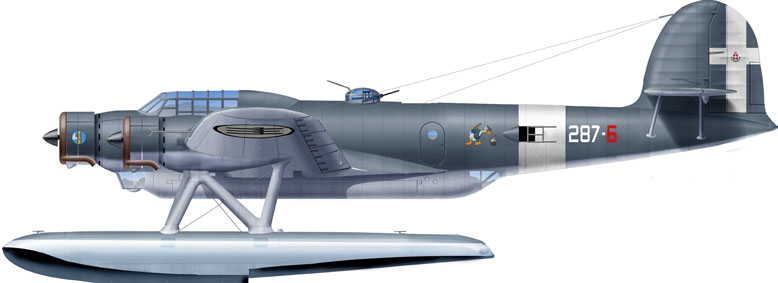
The "Heron", developed in 1937, was a torpedo bomber and a rescue aircraft highly appreciated because it was manageable, fast and rugged. The Germans also used it from 1943 in the Mediterranean, especially the Z506s soccorsio version. The talian ones had a very visible livery, with stripped wings in red and white bands. These aircraft were operational as early as 1939, and 324 were manufactured. Its qualities made it remained in service until the 1950's. Defended by three light machine guns, these were still able to carry a 457 mm torpedo or 1200 kgs. of bombs. Powered by three Alfa Romeo 126 RC34 radial engines of 750 hp, they could fly at 365 Km/h, and had a 2,000 km range. During their patrols on the Greek islands, they sank at least one British submarine.
 Caproni-Reggiane Re2000
Caproni-Reggiane Re2000
 Reggiane Re2000 in her livery of North Africa at the beginning of the conflict. the 10 copies made for the navy were more generally dark gray. Without floats, they were not recoverable and constituted a one-time defense; like the Hurricanes embedded on British CAM-ships. Two served on the Roma, one on the Litorrio. Speed: 530 Km / h, engine: Piaggio PXI bis 1000 hp, armament 2 mitt. 12.7 mm.
Reggiane Re2000 in her livery of North Africa at the beginning of the conflict. the 10 copies made for the navy were more generally dark gray. Without floats, they were not recoverable and constituted a one-time defense; like the Hurricanes embedded on British CAM-ships. Two served on the Roma, one on the Litorrio. Speed: 530 Km / h, engine: Piaggio PXI bis 1000 hp, armament 2 mitt. 12.7 mm.
 Caproni-Reggiane Re2002 Ariete
Caproni-Reggiane Re2002 Ariete
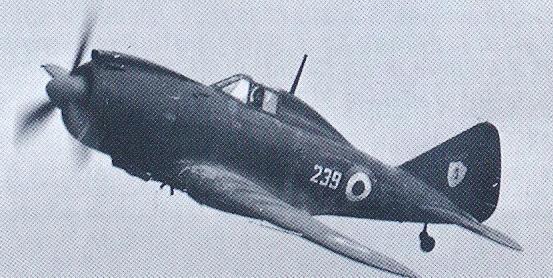
Clearly more efficient, the Re2002 existed in version in motor in line and in star. Some copies were used instead of the Re2000 in 1943 on the Italian cruisers .. Speed: 590 Km / h, engine: Piaggio PXI bis of 1050 hp, armament 2 guns of 20 mm, 2 mitt. 7.7 mm. Re 2001 was anticipated to be navalized and used on Aquila.
 Medidionali IMAM Ro-43/44
Medidionali IMAM Ro-43/44

IMAM Ro 43
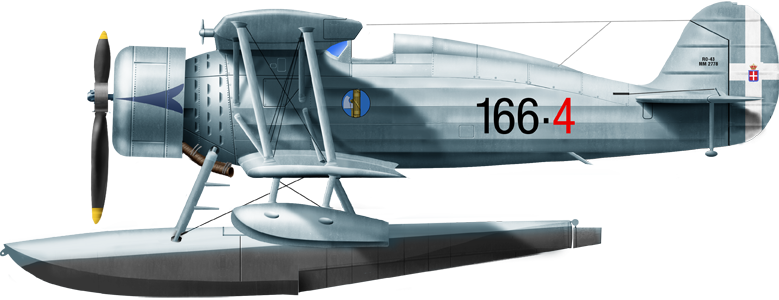
IMAM Ro 44 Octopus
These aircraft, developed in 1936 on the basis of the Ro37 terrestrial observation aircraft, will be the standard observation and fighter aircraft of the fleet until 1943. They were maneuverable and solid but slow. The Ro44 version of 1939 was a single-seat version of hunting, under-powered and poorly armed. 106 were in service in 1940, and 194 will be produced in all. Speed: 300 Kmh, engine: Piaggio PXR 700 hp, armament 2 mitt. 7.7 mm.
 Savoia-Marchetti SM79 II Sparviero
Savoia-Marchetti SM79 II Sparviero
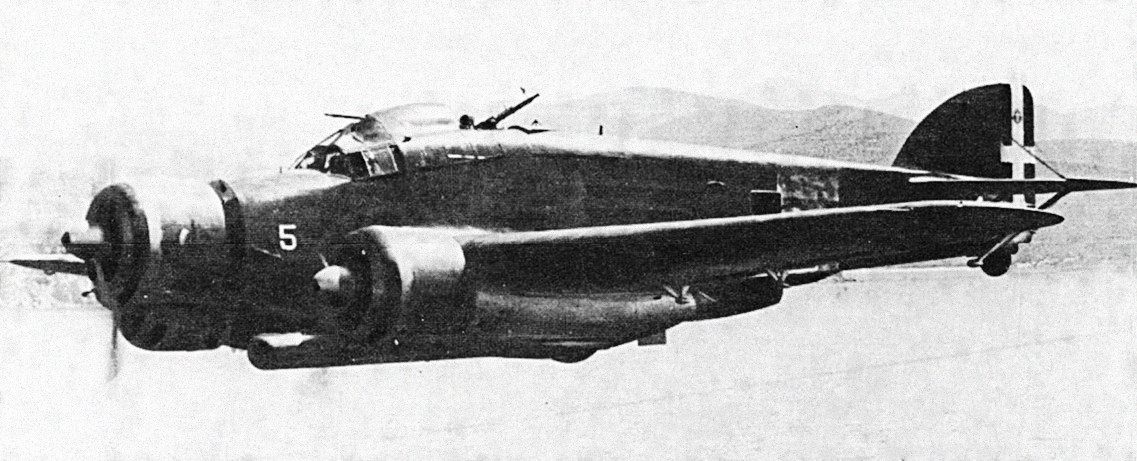
Savoia-Marchetti Sm 79 Sparviero
These famous Italian bombers, among the most prolific of the Regia Aeronautica, were originally from civil aircraft, remotorized for service from 1934. In version I succeded the much faster and more powerful version II, intended especially for the Naval Aviation. These aircraft embarked two torpedoes of 457 mm. Speed 460 Kph, 3 engines Fiat 1030hp.

Savoia Marchetti SM-79 Sparviero
 Savoia-Marchetti SM84
Savoia-Marchetti SM84

The Savoia-Marchetti SM.84 was a successor twin-engine medium bomber of World War II, to the successful SM.79 Sparviero. Despite high expectations, the SM.84 was not particularly successful and is generally regarded as a disappointment for several reasons. Its First Flight was in 1940 as a Medium bomber and torpedo bomber with a 4-5 crew, two Piaggio P.XI RC.40 radial engines (around 1,000 hp each) for ~460 km/h (285 mph) and a range of about 2,000 km (1,240 mi). It was defended by three 12.7 mm Breda-SAFAT machine guns and could carry either 1,200 kg of bombs or two 450mm torpedoes.
The SM84 turned to have Handling Problems, it was more difficult to fly than the SM.79. It also had stability Issues with poor flight characteristics, especially during takeoff and landing. Crew Visibility was considered mediocre, hampering navigation and bombing accuracy. Combat Performance were inferior to both Axis and Allied contemporaries and at the stage it entered service in 1942 it saw limited success in torpedo bombing and conventional bombing roles. The Mediterranean theater started indeed to shift against the axis. It operated against Allied convoys, including Malta and North Africa but was phased out by 1943. It looked promising on paper, but its overall performances and combat record was underwhelming, it never live up to the Sparviero's fame.
 Oddities
Oddities

C205 Bif/S aerosilurante, prototype silurotto torpedo tested by mid-1943 in Bari (concept).
- Lohner E (1913)
- Macchi M3 (1916)
- Macchi M5 (1918)
- Ansaldo ISVA (1918)
- Sopwith Baby (1916)
- Short 184 (1916)
- Fairey Campania (1917)
- Sopwith Cuckoo (1917)
- Felixstowe F.2 (1917)
- Friedrichshafen FF 33 (1916)
- Albatros W4 (1916)
- Albatros W8 (1918)
- Hanriot HD.2
- Grigorovitch M5
- IJN Farman MF.7
- IJN Yokosho Type Mo
- Yokosho Rogou Kougata (1917)
- Yokosuka Igo-Ko (1920)
- Curtiss N9 (1916)
- Aeromarine 39
- Vought VE-7
- Douglas DT (1921)
- Boeing FB.5 (1923)
- Boeing F4B (1928)
- Vought O2U/O3U Corsair (1928)
- Blackburn Blackburn (1922)
- Supermarine Seagull (1922)
- Blackburn Ripon (1926)
- Fairey IIIF (1927)
- Fairey Seal (1930)
- LGL-32 C.1 (1927)
- Caspar U1 (1921)
- Dornier Do J Wal (1922)
- Rohrbach R-III (1924)
- Mitsubishi 1MF (1923)
- Mitsubishi B1M (1923)
- Yokosuka E1Y (1923)
- Nakajima A1N (1927)
- Nakajima E2N (1927)
- Mitsubishi B2M (1927)
- Nakajima A4N (1929)
- CANT 18
WW1
✠ K.u.K. Seefliegerkorps:
 Italian Naval Aviation
Italian Naval Aviation
 RNAS
RNAS
 Marineflieger
Marineflieger
 French Naval Aviation
French Naval Aviation
 Russian Naval Aviation
Russian Naval Aviation
 IJN Air Service
IJN Air Service
 USA
USA
Interwar
 Interwar US
Interwar US
 Interwar Britain
Interwar Britain
 Interwar France
Interwar France
 Interwar Germany
Interwar Germany
 Interwar Japan
Interwar Japan
 Interwar Italy
Interwar Italy
- Curtiss SOC seagull (1934)
- Grumman FF (1931)
- Curtiss F11C Goshawk (1932)
- Grumman F2F (1933)
- Grumman F3F (1935)
- Northrop BT-1 (1935)
- Grumman J2F Duck (1936)
- Consolidated PBY Catalina (1935)
- Brewster/NAF SBN-1 (1936)
- Curtiss SBC Helldiver (1936)
- Vought SB2U Vindicator (1936)
- Brewster F2A Buffalo (1937)
- Douglas TBD Devastator (1937)
- Vought Kingfisher (1938)
- Curtiss SO3C Seamew (1939)
- Douglas SBD Dauntless (1939)
- Grumman F4F Wildcat (1940)
- F4U Corsair (NE) (1940)
- Brewster SB2A Buccaneer (1941)
- Grumman TBF/TBM Avenger (1941)
- Consolidated TBY Sea Wolf (1941)
- Grumman F6F Hellcat (1942)
- Curtiss SB2C Helldiver (1942)
- Curtiss SC Seahawk (1944)
- Grumman F8F Bearcat (1944)
- Ryan FR-1 Fireball (1944)
- Douglas AD-1 Skyraider (1945)
Fleet Air Arm
- Fairey Swordfish (1934)
- Blackburn Shark (1934)
- Supermarine Walrus (1936)
- Fairey Seafox (1936)
- Blackburn Skua (1937)
- Short Sunderland (1937)
- Blackburn Roc (1938)
- Fairey Albacore (1940)
- Fairey Fulmar (1940)
- Grumman Martlet (1941)
- Hawker sea Hurricane (1941)
- Brewster Bermuda (1942)
- Fairey Barracuda (1943)
- Fairey Firefly (1943)
- Grumman Tarpon (1943)
- Grumman Gannet (1943)
- Supermarine seafire (1943)
- Blackburn Firebrand (1944)
- Hawker Sea Fury (1944)
IJN aviation
- Aichi D1A "Susie" (1934)
- Mitsubishi A5M "Claude" (1935)
- Nakajima A4N (1935)
- Yokosuka B4Y "Jean" (1935)
- Mitsubishi G3M "Nell" (1935)
- Nakajima E8N "Dave" (1935)
- Kawanishi E7K "Alf" (1935)
- Nakajima B5N "Kate" (1937)
- Kawanishi H6K "Mavis" (1938)
- Aichi D3A "Val" (1940)
- Mitsubishi A6M "zeke" (1940)
- Nakajima E14Y "Glen" (1941)
- Nakajima B6N "Jill" (1941)
- Mitsubishi F1M "pete" (1941)
- Aichi E13A Reisu "Jake" (1941)
- Kawanishi E15K Shiun "Norm" (1941)
- Nakajima C6N Saiun "Myrt" (1942)
- Yokosuka D4Y "Judy" (1942)
- Kyushu Q1W Tokai "Lorna" (1944)
Luftwaffe
- Arado 196 (1937)
- Me109 T (1938)
- Blohm & Voss 138 Seedrache (1940)
Italian Aviation
- Savoia-Marchetti S.55
- IMAM Ro.43/44
- CANT Z.501 Gabbiano
- CANT Z.506 Airone
- CANT Z.508
- CANT Z.511
French Aeronavale
- GL.300 (1926-39)
- Levasseur PL.5 (1927)
- Potez 452 (1935)
- Loire 210 (1936)
- Loire 130 (1937)
- LN 401 (1938)
Soviet Naval Aviation
- Shavrov SH-2 (1928)
- Tupolev TB-1P (1931)
- Beriev MBR-2 (1930)
- Tupolev MR-6 (1933)
- Tupolev MTB-1 (1934)
- Beriev Be-2 (1936)
- Polikarpov I16 naval (1936)
- Tupolev MTB-2 (1937)
- Ilyushine DB-3T/TP (1937)
- Beriev Be-4 (1940)
-
Skoda Š-328V
R-XIII Idro
Fokker C.XI W (1934)
WW2
- De Havilland Sea Vixen
- Hawker Sea Hawk
- Supermarine Scimitar
- Blackburn Buccaneer
- Hawker Sea Harrier
- Douglas A4 Skyhawk
- Grumman F9F Panther
- Vought F8 Crusader
- McDonnell-Douglas F-4 Phantom-II
- North Am. A5 Vigilante
- TU-142
- Yak 38 forger
☢ Cold War
✧ NATO
 Fleet Air Arm
Fleet Air Arm
 US Navy
US Navy
☭ Warsaw Pact
Merch

Seafire Mark 45; HMS Pretoria Castle

Zeros vs its aversaries

Aichi D3A “Val” Junyo

Mitsubishi A5M poster

F4F wildcat

Macchi M5

SBD Dauntless Coral Sea

SBD Dauntless USS Enterprise

SBD-4 CV22